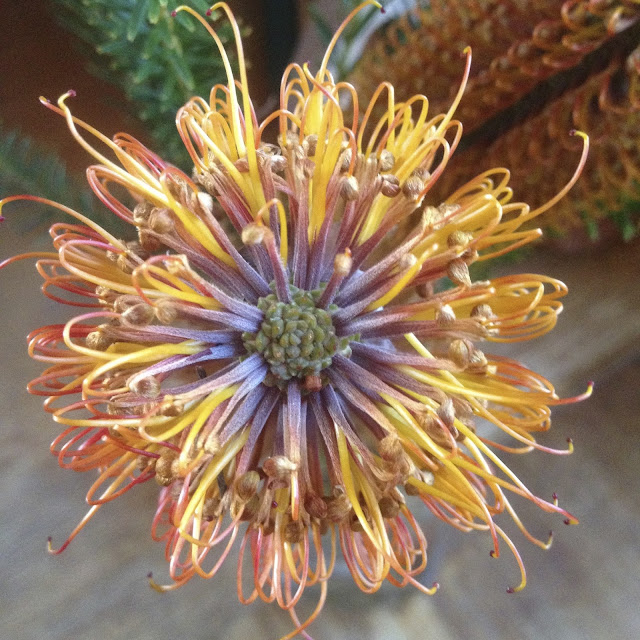Waratah season is short and sweet. They are very much a spring flower.
 |
| Swallows Nest Farm Waratah Bouquet |
This year has been unusually warm and the waratah season seemed to fly by more quickly than usual. Here at Swallows Nest Farm, you can see the first pickable blooms in mid to late September, with October being the high season. Some late flowering varieties keep going until mid December, but due to the warmth, it been a shorter season. It's made me a bit sad, and so to console myself, I've compiled a little collection of waratah wedding bouquets.
 |
| Flowergirl's bouquet Swallows Nest Farm |
Some are my own, and some are ones I've found on my internet travels. All of them feature the wonderful waratah in different ways and different styles.
These first two bouquets are from an early October wedding. The waratah's are just coming into their peak season and are vibrant and fresh. The colour in these "Shady Lady" variety is really rich. Teamed with the lipstick boronia it makes for a really colourful statement.
This one is an early spring bouquet from mid September. The waratah in this bouquet is not fully open and the colour is not as vibrant, but the pink makes for a more subtle look and I love the petals still arching up around the flower. Pretty and fresh.
 |
| Good Grace and Humour |
What a great image! I love the red and white! In this wedding the white waratah makes an appearance. I think it really works!
 |
| Good Grace and Humour |
Red waratah for the bride and white for the bridesmaids. Fabulous!
 |
| October Waratah Wedding Swallows Nest Farm |
From mid October, this bouquet celebrates the waratah in its peak season here in Tasmania. The first early Tasmanian waratah makes an appearance towards the back left. The Tasmanian waratah starts in October and peaks in November, usually, with some lingering into December.
 |
| October Waratah Wedding Swallows Nest Farm |
I love this combination of fresh colours celebrating spring. Simple style to highlight the flowers at their best.
 |
| Spring Native Wedding Swallows Nest Farm |
This trio of bouquets is from early October. Lots of cream and white, with touches of gold from the Dryandra/Banksia Formosa make a great background for the waratahs.
 |
| November Native Wedding Swallows Nest Farm |
Novermber and the first of the Pincushion proteas have emerged but the waratahs are still going. I have found that our white waratahs flower a little later than the red, and this means that they can be available for weddings as the weather warms up. The texture the waratah gives is an important ingredient of the success of this bouquet. I love playing with colour blends using the white waratahs too.
 |
| White Waratah Spring bouquet, Swallows Nest Farm |
This bride's bouquet features a white waratah too, but with a different style and colour scheme. The theme was "rustic vintage style" in classic pink and soft tones.
 |
| White Waratah Spring Wedding Swallows Nest Farm |
I love the texture in the bouquet. A more subtle colour scheme lets you really play with texture.
 |
| Tasmanian Waratah bouquet Swallows Nest Farm |
November is Tasmanian Waratah month here at Swallows Nest Farm, and a gorgeous bride who loves her Tassie Waratahs chose November for her wedding so she could have one of her favourite flowers as the centrepiece of her bouquet. Simple, beautiful fresh flowers.
 |
| Swallows Nest Farm |
A wedding featuring the Tasmanian waratah couldn't have been held in a more perfect setting. This classic Tasmanian beach scene with the gorgeous blue of the sea and the characteristic orange lichen on the rocks. Beautiful!
 |
| Waratah and Kangaroo Paw by Good Grace and Humour |
 |
| Field and Coppice Floral Design |
 |
| Field and Coppice Floral Design |
Waratahs are a stunning spring favourite for weddings. Keep an eye out for them!






































